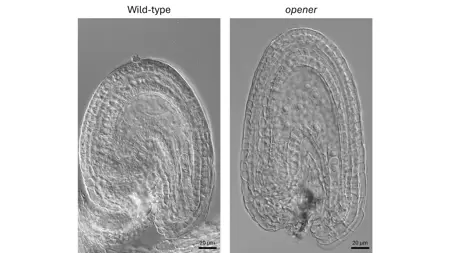
Unlocking nature’s blueprint – scientists identified the function of a so far uncharacterised protein complex
Scientists have uncovered the functions of many genes and proteins across different organisms, but much is still unknown. Now, researchers at Umeå Plant Science Centre have identified the function of a protein complex involved in establishing protein production in plants.
Thale cress, or Arabidopsis, is the most extensively studied plant on Earth. Its genome was sequenced over 25 years ago, but the function of approximately one third of the genes still remain unknown. To explore this uncharted territory, Totte Niittylä and his team began investigating essential genes and proteins that are evolutionarily conserved across plant species.
“We aimed to break new ground by identifying uncharacterised essential cellular processes in plants”, said Totte Niittylä. “Our search focused on unknown genes which are essential for early seed development in Arabidopsis. What we discovered was a gene without which seeds stop growing at a very early stage after fertilisation when the egg cell has been fused with the pollen sperm cell.”
A protein with unusual dual localisation in the cell
The team named this gene ‘OPENER’, inspired by the shape of the first cell formed after fertilisation, which stops growing in the mutants and resembles a bottle opener when observed under a microscope. In the wild type plants, there is no bottle opener shape, and the initial cell continues to divide and develops into the embryo contained within the seed.
As the researchers began to study the OPENER protein in detail, they found that it had an unusual localisation in the cell. It was localised both around the nucleus, where the DNA is stored, and around the mitochondria, which are necessary for the cell’s energy production. The team reported these results already in an earlier publication describing the initial discovery of the OPENER protein.
Curious by this unusual dual localisation the team delved deeper into the function of the OPENER protein and identified two other proteins that interact with it. These two proteins were also of unknown function and showed the exact same localisation in the cell as the OPENER protein. However, the breakthrough came when the researchers combined cell biology and biochemistry with AlphaFold, an artificial intelligence-based tool that predicts protein structure based on its amino acid sequence.
Modelling the 3D structure of the protein led to the breakthrough
“We realised that the three proteins have a similar structure and combine to form a distinctive three-fingered, claw-like structure. This was the “AlphaFold moment” of the project”, said Wei Wang, first author of the study and former postdoctoral researcher in Totte Niittylä’s group at Umeå Plant Science Centre. “We also searched for structures similar to OPENER in other organisms and identified a human protein which had recently been linked to ribosome assembly. Although OPENER and the human protein are not similar in amino acid sequence they have almost identical 3D structure. This gave us a clear lead to explore.”
Using AlphaFold, the researchers predicted the 3D structure of the OPENER protein and its two interaction partners and saw that all three proteins had a similar structure. Video: Wei Wang.
Ribosomes are the cellular machines responsible for protein production. Before proteins can be made the different components of the ribosome need to be assembled. Wei Wang and Totte Niittylä teamed up with the Umeå University based groups of ribosome expert Johannes Hanson and André Mateus, who specialises in protein analysis. Together they used a combination of cutting-edge tools to reveal that the OPENER complex consists in total of five different proteins and demonstrated that it is essential for ribosome assembly in plants.
Ribosome assembly is more complex in plants than previously thought
“Ribosomes are fundamental for protein synthesis and consequently for the growth and survival of the organism”, explained Totte Niittylä. “The process of making ribosomes requires energy and resources and as such requires careful regulation. The OPENER complex appears to add an extra layer of control to this fundamental cellular process.”
Wei Wang who has recently moved to a new position at the Yazhouwan National Laboratory in Sanya, China, added: “Our study suggests that the regulation of ribosome assembly and consequently protein biosynthesis in plants is even more complex than previously thought and occurs in distinct subcellular locations. This discovery opens exciting new avenues for fundamental research not only in plants but possibly also in other higher organisms such as animals and human.”
Curiosity-driven science lays the groundwork for future inventions and understanding how plants grow and develop is important when looking for ways to protect our food supply from the impacts of climate change. Given the central role of ribosomes for protein synthesis and plant growth, the study presents new opportunities for investigating crop yield and performance.
About the article
Wei Wang, Amir Mahboubi, Shaochun Zhu, Johannes Hanson, André Mateus & Totte Niittylä. Ribosome biogenesis in plants requires the nuclear envelope and mitochondria localized OPENER complex. Nature Communications 16, 7301 (2025).
Link to the article published in Nature Communications
Link to the previous publication in The Plant Cell describing the initial discovery of OPENER
Contact
-
PersonTotte Niittylä, professorDepartment of Forest Genetics and Plant Physiology